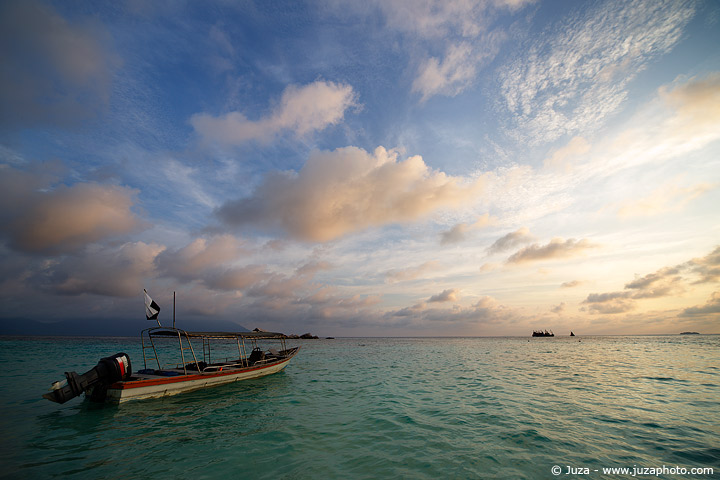Shooting data: Canon EOS 1Ds Mark III, Sigma 12-24mm f/4.5-5.6 EX DG HSM, 1/60 f/8, iso 50, tripod. Pulau Tulai, Malaysia. During my recent trip to Malaysia I have visited various islands, and a couple of times I have been lucky enough to see magnificent sunsets, with pink and yellow clouds in the sky. One of the most beautiful experiences has been the sunset from Pulau Tulai, a very small island few kilometers from Tioman. Pulau Tulai is uninhabited, but you can reach it with small boats that bring groups of tourists on the island for few hours. For about 300 Ringitt (65 Eur), we organized a custom tour all for ourselves, with the possibility to stay on the island until sunset, so at 6 p.m., me and my friend Daniela begun takin photos...we had all the island for us, and we enjoyed a truly marvelous sunset. Daniela had a Canon 1DIII, while I have taken nearly all my sunset photos with the 1DsIII and my beloved Sigma 12-24, the most amazing wide angle I have ever used!
What makes the 12-24 so special is its unparalleled 122 degrees angle of view at 12mm (the focal length I use more often with this lens), combined with a nearly inexistent distortion. The perfectly straight horizon you see in this photo is a gift of the 12-24, I have not corrected the distortion with PS...impressive, and much better than all other wide angles I have tried.
I mounted the camera on tripod and I have carefully composed the photo. The ship on the left is the small ship that we used to reach the island, and it is also a good compositional anchor - it balances the image and it adds interest. The small silhouettes on the horizon are some fishermen ships and another little island; even though they are really small at web size, in larger versions of the photo I think they add to the composition. I have focused the image with live view (of course using manual focus...I almost always use MF for landscapes, and anyway AF of my Sigma 12-24 has broken long time ago, so I have no other options); I have chosen an aperture of f/8, that gave a shutter speed of 1/60, because here I did not wanted water blur.
As many of my landscape and macro photos, this photo is taken at ISO 50. I am often asked why using ISO 50 instead of ISO 100, since it gives 1 stop less dynamic range. It is important to understand how ISO 50 "works": when you select ISO 50, the camera actually takes a photo at ISO 100 overexposing by 1 stop, then it brings back the brightness of the image to create the "ISO 50" RAW file. This procedure is nearly the same of "exposing to the right", that is overexposing the photo as much as possible (without blowing out the highlights or a color channel) and then decreasing the brightness during RAW conversion: the only difference is that by using ISO 50 the camera already "exposes to the right" by 1 stop, so you need to use less positive exposure compensation, or sometimes even none or a negative exposure compensation, to get the brightest histogram without losing the lights.
The advantages of ISO 50/exposing to the right are that you get a cleaner image, with more post processing possibilities. Even ISO 100 photos are very clean, but sometimes you can see a little of noise in the dark areas if you do strong contrast or saturation enhancements, while with ISO 50 photos these artifacts are further reduced.
Replies and comments
What do you think about this article?
Do you want to tell your opinion, ask questions to the author, or simply congratulate on a particularly interesting article? You can join the discussion by joining JuzaPhoto, it is easy and free!
There is more: by registering you can create your personal page, publish photos, receive comments, join discussions and you can use all the features of JuzaPhoto. With more than 256000 members, there is space for everyone, from the beginner to the professional.


 JuzaPhoto contains affiliate links from Amazon and Ebay and JuzaPhoto earn a commission in case of purchase through affiliate links.
JuzaPhoto contains affiliate links from Amazon and Ebay and JuzaPhoto earn a commission in case of purchase through affiliate links.